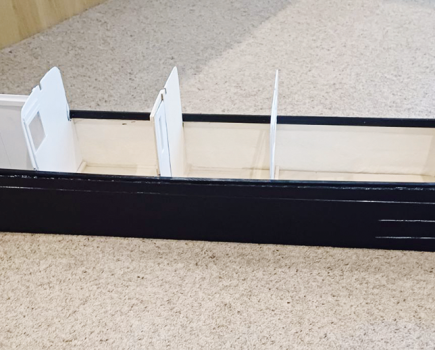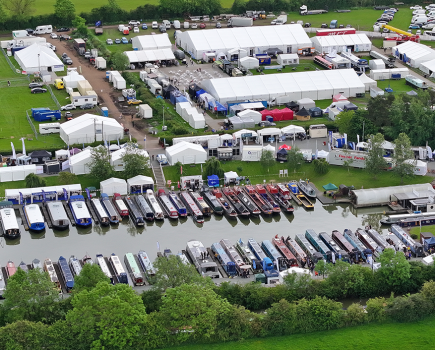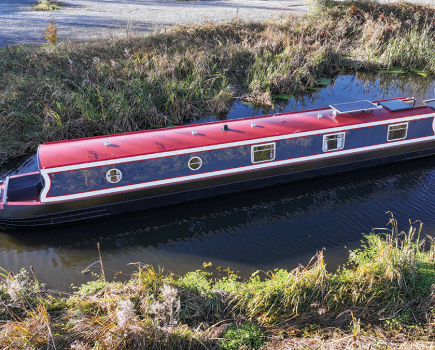If you want to make an informed decision concerning boat refrigeration we must think about some basic science. If you already know the difference between temperature and heat – please skip the next section

The Science
Heat is a form of energy, if you add heat to something it will contain more energy and its temperature will rise. Conversely remove energy and its temperature will fall. If we put something under a powerful microscope we could see the energy because all the molecules would be bouncing about. If we then took energy away from it, that is cool it, the molecules would slow down and the temperature would fall. Eventually at –273C there would be no energy left and the molecules would be still (in theory). This shows that even very cold ice still has lots of heat energy in it. When we wish to store “cold” we need to take the energy away from it.
Some substances need more energy put into them to raise their temperature than others. This is known as a substance’s specific heat capacity and if we want to store “cold” one way would be to use a substance that requires lots of energy to raise or lower its temperature.
Heat energy is also required to change a substance from solid to a liquid or from a liquid to a gas. Some substances require more heat than others. This is known as a substance’s latent heat. Another way to store cold is to use an “ice” substance that requires lots of heat energy to change it to a liquid at around the refrigeration temperature.

A fridge or freezer is only a heat pump that pumps heat away from its inside and deposits it into the air, usually at the back of the fridge.
Lastly heat always tries to flow from hot to cold. How well it manages depends upon the substance its flowing through. Fridge insulation makes this flow difficult, but some insulation materials are better than others.
Refrigeration Methods

There are three technologies that are employed to produce refrigeration for boats.
1. Absorbtion
This uses heat to cause liquid to circulate in a closed system and is the system used in gas fridges and the gas/mains/12 volt fridges. It is silent in operation, but requires the highest current flow. Expect between 6 and 8 amps. Many of these fridges have no 12 volt thermostat so unless you are sure they have one calculate a draw of 8 amps over 24 hours. However you will turn it off once the milk and tomatoes go solid!
These fridges must be installed so they remain within 6 degrees of the horizontal, so if your boat has any tanks to one side, level the fridge with the tanks half full.
As far as I can tell all makes of these fridges now use the same “works” so their performance should be similar.
2. Thermo-electric or Peltier
This uses a large “diode like” structure. When current is passed through it heat is transferred from one side to the other. This means one end can be used to cool and the other to heat. If the current flow is reversed the “cold” end gets hot and the “hot” end gets cold. This is the technology used in car fridges and cool boxes which explains why some of them will either heat or cool.
They often use a small electric fan to blow the heat away from the hot end when used in fridges/cool boxes so there will be some noise. It is important that this airflow is not impeded.
They may or may not have a thermostat and they draw about 4 or 5 amps. When fitted with a thermostat the manufacturer may state an “average consumption” or “typical running times”. Expect it to run for at least 20% of the time, so over 24 hours it to require about 24 amp hours of battery capacity.
3. Compressor
This is the “main” fridge technology. An electrically driven compressor circulates a liquid so there will be some noise. All the easily available low voltage fridges use the same basic compressor/motor/control unit (Danfoss DV35) so their basic performance will be similar unless the manufacturer adds “extras” or uses better insulation.
These automatically adjust for 12/24 volt operation and at 12v they draw about 3 amps and will be fitted with a thermostat. Tests by another magazine confirm my experience that the average consumption in a well-installed fridge will be less than half this, so allow about 30 amp hours (half for 24 volt operation).
At the present time it is unclear whether a 12 volt fridge or a mains A or A+ rated fridge and a well matched inverter will consume the least electricity. However if you go down the inverter plus mains fridge route you have two things to go wrong instead of just the fridge, but you will have 240 vac for other things.
Which Fridge Is Right For You?
As so often there is no right or wrong answer, it all depends upon what you are happy with and how you use and equip your boat.
Gas fridges
As long as you do nothing silly to the boat’s ventilation AND you regularly check the flame for yellow parts a gas fridge is probably safer than a gas cooker. Even a non-room sealed one! Now the Boat Safety Scheme has been relaxed I would be happy to have one on my diesel boat. The danger of a fridge igniting petrol fumes means I would never have one anywhere near a petrol boat – even an outboard! Periodically turn the fridge off for about 60 seconds and then try to re-light it WITHOUT pressing the flame failure button. If it ignites do not use it until the flame failure device is rectified.
However as soon as the flame starts to turn yellow it will be producing carbon monoxide (CO) so requires urgent attention, even if you were silly enough to ignore it the flue may then carbon up and make acrid smells. You will not ignore that.
The Dometic room sealed gas fridge removes most of the dangers from CO, but it costs as much as a “top -line” compressor fridge.
Low voltage absorbtion fridges
The 12v operation on absorption fridges is designed so caravanners can keep their fridges cold whilst driving to their site. The high current demand makes them the least suitable for marine use.
Low voltage compressor fridges
As they all use the same basic compressor unit your choice will come down to aesthetics, comparative costs, and how vital you may find any added features. The main players in the higher priced market have been conspicuous by their inability to supply me with independent confirmation of their claims for reduced current demand, however the science supports a reduction, but how much is open to some question.
Some now claim “Tropical cabinets”. I think this just means better insulation so less outside heat can get in, possibly like the A+ rating on domestic fridges.
They also fit “Holding plates”. These are either solid plates with a high specific heat or hollow plates filled with a liquid with a high latent heat. Once the fridge is down to temperature the heat leaking in from the outside will be absorbed by the plates as they either heat up or the liquid melts. To a degree how effective this is at reducing current flow will depend upon the way the boat’s charging system is being used, but it will lengthen the time the thermostat keeps the compressor turned off. This feature can be partially reproduced by filling the spare space in the fridge with freezer blocks or cans/bottles of liquid refreshment.
Another tactic is to use electronics to switch something a bit like “super-freeze” on when the charging system is running and thus cool the holding plates as fast as possible.
I can see the advantages of these techniques for sailing boats and others that only run their engines for short periods, but on inland boats where the weight and space penalty of an extra battery is not significant I question the wisdom of paying for them.
Some of these fridges are supplied with a remote compressor, water cooled “radiator”, or without a case for building into the structure of the boat. These are expensive and are probably more at home on a large yacht or motor cruiser than on a narrowboat.
Thermo-electric
At the moment these are mostly in the form of top opening cool boxes, so the boat would need to be designed to house them. As this is a comparative new technology and they are aimed at the consumer-leisure market we can not be sure about how durable they are.
Aesthetics
In my view the basic Shoreline/Inlander type should be perfectly satisfactory, but it will have a steel cabinet, which will rust if scratched, and a plastic inner lining which can stain. Pay more and you get things like the ability to fit decorative door panels, aluminium or stainless steel linings, stainless steel cabinets, “built in” units, or the extra features discussed above.
Maximising efficiency
The more efficient a fridge is able to cool the shorter the time it will run and draw current. This helps preserve battery charge.
Every time you open a cabinet fridge or freezer all the cold air “falls down” and spills all over the floor, allowing warm air in. This is likely to make the thermostat cut in. To overcome this one needs a top opening design. This is more important with freezers because they operate at a lower temperature. If your refrigeration needs are modest there are Draw fridges available which would contain the cold air in an opening draw.
At the back of absorption and compressor fridges is the radiator where they get rid of the heat they have removed from the inside. The cooler this area is the more efficient the fridge. At the very least observe ALL the manufacturer’s recommendations concerning gaps around the fridge. Never block any vents on built in units.
Dometic make a plastic vent to fit above their absorption fridges. This has a thermostat and fan so as the temperature above the fridge rises the fan cuts in and draws the heat away. As these fridges are probably running on gas from large bottles any increase in efficiency may not be worth the cost in any but the hottest weather. Over very long periods absorption fridges seem to loose their efficiency, sometimes they can be “revived” by turning the fridge upside down and hitting the “radiator” at the back and then letting it stand the correct way up for a while before turning it on. If it’s a gas fridge always make sure the flame is nice and blue first. Also remember you need a competent person to deal with the gas work.
The Danfoss control unit has connections for a fan or fans so they cut in when the compressor does. These can be used to blow cold air up the back of the fridge. The air in the bilges is normally the coolest on the boat, so as long as they are clean and not smelly a good plan is to draw the air up from the bilge. A 12 volt computer fan draws very low power and is cheap to buy – possibly free if you are into skip rummaging!
If such a fan is too noisy at least cut some ventilating holes in the floor so convection draws cool air over the back of the fridge.
If it is not possible to provide ventilation around the fridge you might be able to fit large vents to one or both sides. Fit a lower and upper one to allow for convection.
Wiring compressor fridges
When a Danfoss compressor starts it draws a high current, its control system also monitors the voltage at its input. The fridge will shut down and report any low voltage it detects. This is often interpreted as resulting from a flat battery, however undersized cables supplying the fridge are often the cause.
It is VITAL to ensure all such fridges are wired as per the manufacturer’s recommendations and to ensure any installer/builder does not “know better” than the manufacturer and do their own thing.
If you already have a compressor fridge that is displaying “flat battery” symptoms, yet you know the batteries are in good condition and reasonably well charged, the cables are likely to be at fault. Fortunately the Danfoss website gives instructions on how to alter the voltage that the fridge considers “too low”. Doing this is not ideal, but may well save rewiring.
The Danfoss terminal block showing the fan connection
Conclusions
Everyone must make their own decisions, but if I was living aboard a diesel boat without a regular shoreline connection I would be happy with a gas fridge. I would not rule one out for a simple cruising boat, especially with a small battery bank or alternator or if I spent long periods moored up. If I was worried about gas then it might be worth buying a fridge with enhanced insulation and holding plates etc.
A basic compressor fridge, either low voltage or mains plus inverter, should be satisfactory for the majority of boats as long as the charging facilities and battery bank can cope with about 20 ah
Image(s) provided by:
Archant







